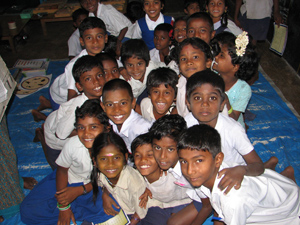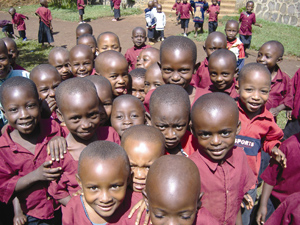Why access to education is important
Over 60 million children of primary school age are not in school. A further 60 million of lower secondary age do not attend. Since 2010 these numbers have remained stubbornly resistant to interventions to universalise access to education despite repeated global commitments to deliver on the promises of education for all. Most are in Sub Saharan Africa and South Asia. Access to basic education lies at the heart of development. Lack of educational access, and securely acquired knowledge and skill, is both a part of the definition of poverty, and a means for its diminution. Sustained access to meaningful learning that has utility is critical to long term improvements in productivity, the reduction of inter-generational cycles of poverty, demographic transition, preventive health care, the empowerment of women, and reductions in inequality.


Encouragingly, enrolment rates in primary schools have improved and the estimated numbers of children out of school in sub-Saharan Africa (SSA) have fallen from about 42-million in 1999 to about 29-million in 2009, and from 37 million to 18 million in South Asia. Gross enrolment rates across SSA now average 102%, and 106% in South Asia, suggesting that more children are enrolled than there are in the six- to 11-year-old age group but that many are overage. Net enrolment rates, which exclude the overage, are less, averaging 76% (86% in South Asia). This confirms that only about three-quarters of primary school age children in SSA are enrolled.
Girls are participating much more than in the past. On average across both SSA and South Asia, for every 100 boys enrolled in the age range there are now 95 girls. But some countries are making slow progress and there are places where boys in school outnumber girls by 20%. Having more boys than girls in school is strongly associated with low overall enrolment rates, high rates of repetition and many overage children in school. Most middle and higher enrolment countries have more girls than boys enrolled.
At secondary school level the magnitude of exclusion is much greater. In many of the poorest countries more than half of all children fail to enrol at secondary level. Of these who do fewer than half will complete a full cycle of secondary schooling and qualify for any further education and training. Those who succeed will be overwhelmingly from richer rather than poorer households. The chances of the poorest 20% completing secondary school can be as little as a tenth that of the richest. And if there are gender gaps in participation in primary schooling, they are almost always larger at secondary level.
The gap between the low enrolment countries and those that are rapidly developing is wide. In China almost all children are enrolled in secondary school as they are in most of south India, but not in the less developed northern states. Africa is dramatically under educated at secondary level when compared to all other regions. Economic growth, which underpins the ability to make a reality of universal access to education, depends on the knowledge and skill that post primary schooling can nurture. Foreign direct investment more often than not flows towards more rather than less educated populations.
In reality there are far more than 60 million primary age children whose right to basic education is denied. Many fail to attend regularly, are seriously over age for the grades they attend, and alarming numbers do not achieve basic skills after 6 years or more of schooling. If these “silently excluded” children are counted then the numbers without meaningful access to primary schooling are well over 250 million. And, if the basic education cycle includes lower secondary, then this number is itself a substantial underestimate of the children whose right to education is compromised.
In 1990 national leaders and international development agencies met in Jomtien in Thailand and committed themselves to universalising access to primary schooling by 2000. In 2000 in Dakar, Senegal, they met again, reviewed progress that had fallen short of expectations, and moved the target to 2015. At Incheon, South Korea the Sustainable Development Goals were adopted that renewed the pledges to make rights realities and extend the commitment to 12 years of formal education for all.
The commitments to Education For All should have resulted in a more equitable participation in basic education; lower levels of gendered inequity; smaller variations in enrolment rates between rich and poor and urban and rural areas; and a smaller spread of achievement between the best and worst performing schools. It should also have reduced the proportions of children who are significantly overage for their grade.
But our research shows that this has often not been the case. Sub-Saharan Africa remains by far the most undereducated part of the world despite allocating proportionally as much or more finance than other regions to education. In South Asia growing inequalities have accompanied economic development and led to very uneven access to basic education and continued marginalisation of the poorest.
In a little more than two decades, governments and development agencies have twice fallen short of aspirations to ensure all children complete schooling successfully. This is a tragedy. It betrays the promises made to yesterday’s children and tomorrow’s young adults.
If all children are to attend school regularly at the right ages and reach levels of achievement that national norms identify, then consistent action is needed tailored to different national systems. Create has generated a 12-point plan that identifies actions critical to making the right to education a reality.
New targets to universalise access to education need to recognise that access is more than enrolment, and that quality, equity and valued outcomes are inseparable if meaningful access to education is to be achieved.
Most of what needs to be known to universalise access is known but is often not applied in practice. The most powerful reasons why so many children miss out on their right to a basic education lie with the political economy of commitments to widen access to opportunity, mobilise domestic resources and manage public services effectively towards clear goals.
There are no good reasons why all children will not attend and complete basic education successfully. If it does not happen it will be testimony to the failure of one generation of adults to believe in the futures of the next.